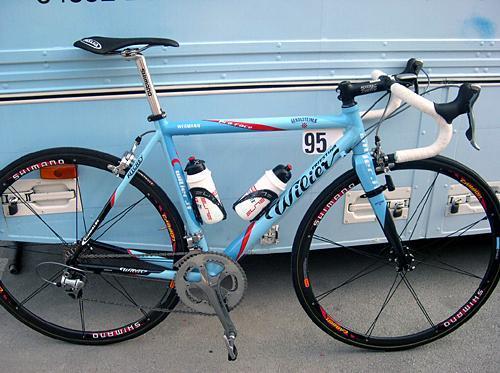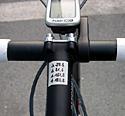
| Team Tech |
| 2004 Teams Database |
| Road Season Preview 2004 |
Recently on Cyclingnews.com |
Pro Team Tech 2004
Reviewed April 10, 2004
Fabian Wegmann's Gerolsteiner Wilier Triestina
World War heroWilier Triestina has experienced its fair share of ups and downs since their inception in 1906. After the company's founders were forced to close their doors shortly after the second World War, the firm from Rossano Veneto has bounced back to produce around 6,000 bicycles a year and take up sponsorship of two division one cycling teams. Cyclingnews' Anthony Tan takes a step back in time and a quick squiz at Fabian Wegmann's Gerolsteiner Wilier Triestina.
Third year professional Fabian Wegmann had an excellent season in only his second year as a professional in 2003, his biggest win coming in Germany's Sachsen-Tour International, albeit an unassuming one (unfortunately for Wegmann, the race was held on the last five days of the Centenary Tour de France). Including a stage win and overall victory, the 23 year-old Gerosteiner pro also won the UCI 1.3-ranked GP Citta' di Rio Saliceto e Correggio just prior to the Sachsen-Tour, and capped off what was already a solid year with second overall at the Rheinland-Pfalz Rundfahrt as well as a string of podium placings in the Criterium International, Tour of Germany, Vuelta al Pais Vasco and the German road championship, finishing third behind Erik Zabel and Patrik Sinkewitz. Wilier Triestina didn't get off to quite the same flying start as Wegmann, although to be fair, few bicycles companies have. Founded in 1906 by Pietro Dal Molin, a tradesman from the town of Bassano del Grappa in northern Italy, Dal Molin began building 'steel horses' as he referred to his frames on the banks of the river Brenta, slowly building his business as the popularity for bicycles increased. Following the first World War, one of his sons, Mario Dal Molin, took control of the company and strove to perfect the process his father began through chromium and nickel plating. Mario was also determined to take advantage of the popularity of cycling - that together with football was the most popular sport in Europe - by creating a professional cycling team named Giordano Cottur, which saw the emergence of a young Gino Bartali. In the autumn of 1945, Wilier Triestina was born, linking the name of the town the factory operated from with that of his company, and in the following year, Fausto Coppi and Bartali were seen duelling on Wilier Triestina frames - which no doubt had much to do with the company's output of 200 bicycles a day by 1946. However, despite another Giro d'Italia winner, Fiorenzo Magni, also growing up on the company's bikes, many people gave up bicycles for scooters and motorbikes in the late 1940s, and in 1952, Wilier Triestina closed its doors. It was not until almost 20 years later that the Gasteldello brothers revived the company through purchase of the Wilier Triestina mark in 1969, setting up their factory in Rossano Veneto, Vicenza, where the firm is still based today. Last year, the company's turnover of 16 million Euros equated to approximately 6,000 complete bicycles and 5,000 frames, with 55 percent sold in Italy and the remainder bound for Germany, Belgium, Spain, USA, Canada, the UK and Austria. Today, Wilier Triestina supply the Team Lampre and Gerolsteiner teams with a range of aluminium and carbon machines, where the company profits from the exposure of star riders Francesco Casagrande and Davide Rebellin. Last season, both squads rode custom-made versions of the Izoard model, named after one of the great mountains in the French Alps, however in 2004, each team will have their own unique framesets.
The bicycle designed to meet the needs and specifications of this year's Gerolsteiner squad is a no-frills, full scandium frame made with Easton GX2 tubing, custom-built for each of the team's 24 riders (which would explain the non-use of carbon-fibre). A semi-compact design - measuring 49cm x 52 cm centre-to-centre for the seat and top tube respectively - with a claimed weight of 1.24 kilograms, Wegmann's Wilier is steered by Mizuno's Fiandre Monoscocca full carbon monocoque fork, adding another 360 grams. Combined with Shimano's new Terminator-esque looking Dura-Ace group, SPD-SL pedals made famous by Lance Armstrong and lightweight carbon wheels (Gerolsteiner team boss Hans-Michael Holczer has always been loyal to Shimano), Ritchey's WCS bars and stem, and the minimalist Selle-Italia SLR XP saddle, it's no surprise Wilier Triestina have come up with a race-ready machine tipping the scales at around the eight kilo mark. On the subject of aesthetics, the Gerolsteiner bubble blue paint job nicely matches the German mineral water team's new-look jersey, reminiscent of the Swiss Frank-Toyo team from the mid-1980s. PhotographyImages by Tim Maloney/Cyclingnews
| |||||||
Full specificationFrame: Wilier Triestina Pro Race Easton Scandium, 49cm seat
tube x 52cm sloping top tube (measured C-C), 1.24kg Cranks: Shimano Dura-Ace FC-7800, 172.5mm |
Rim: Shimano WH-7701-C Carbon Pro Race tubular, 630g (F), 830
g (R) Stem: Ritchey WCS, 130mm, 125g Pedals: Shimano Dura Ace PD-7800, 277g | ||||||



